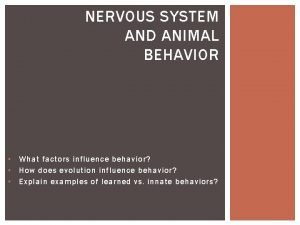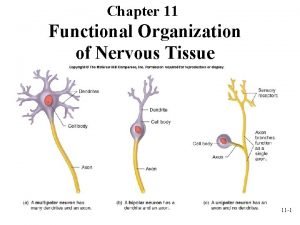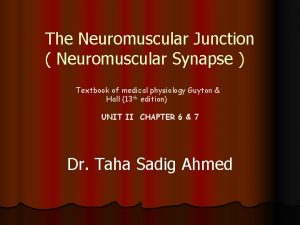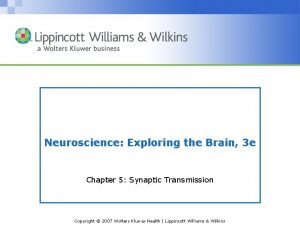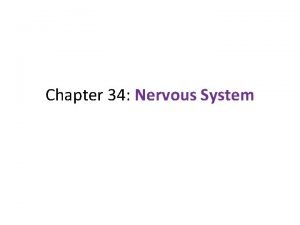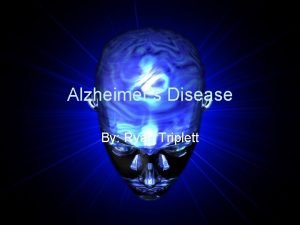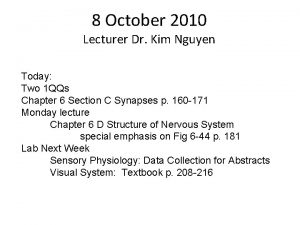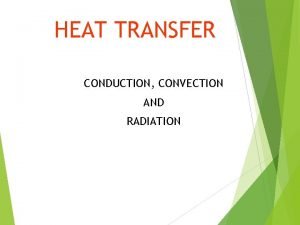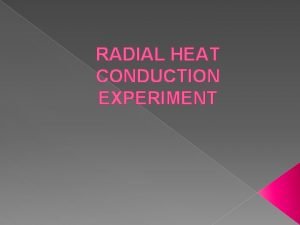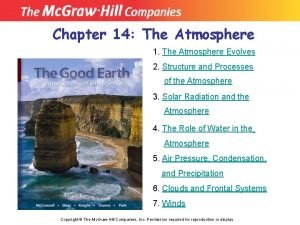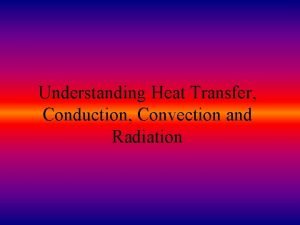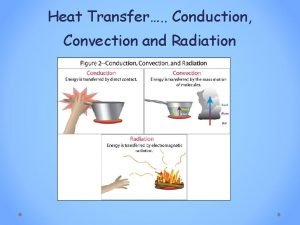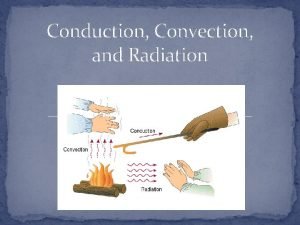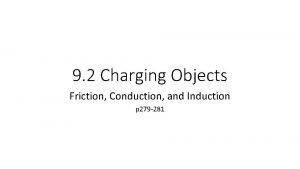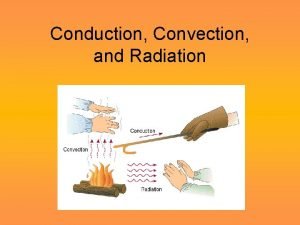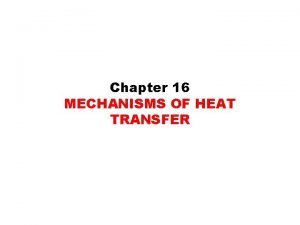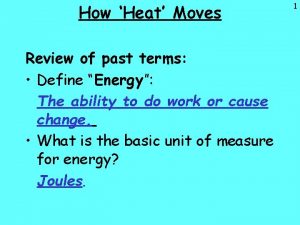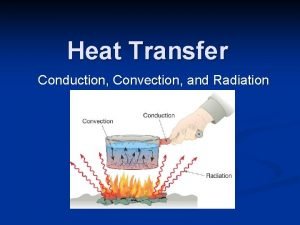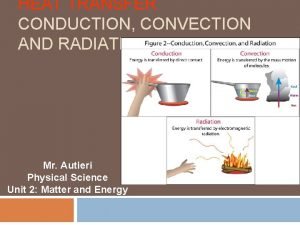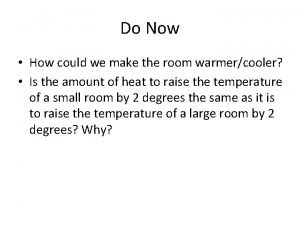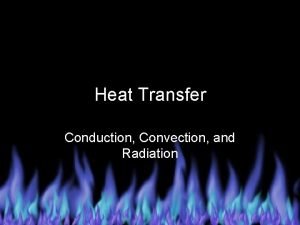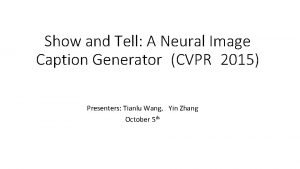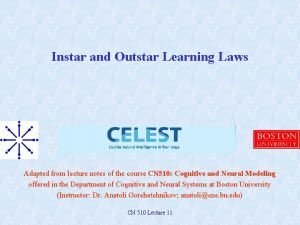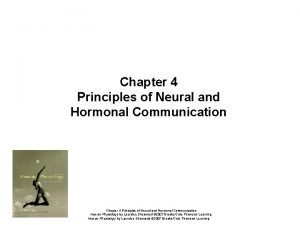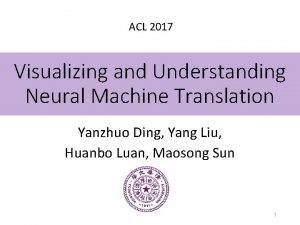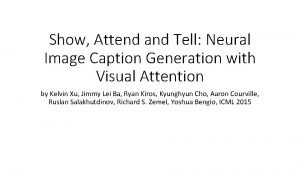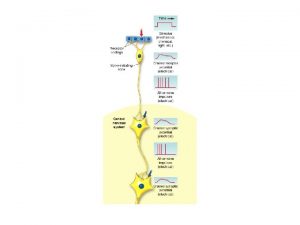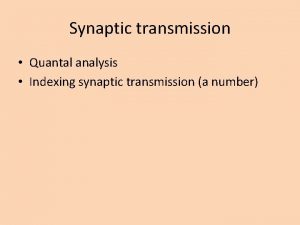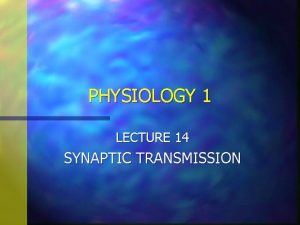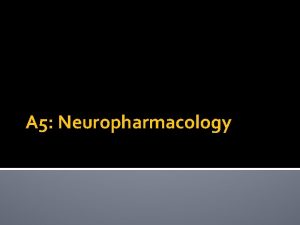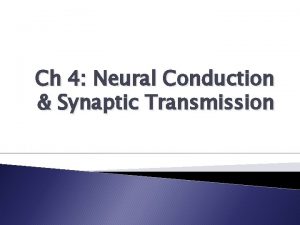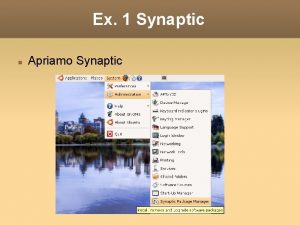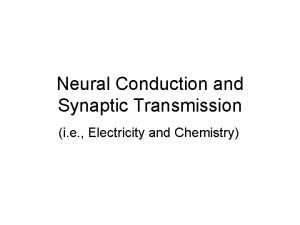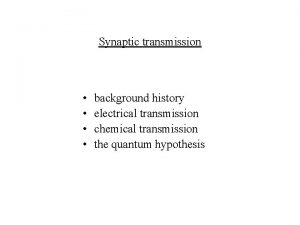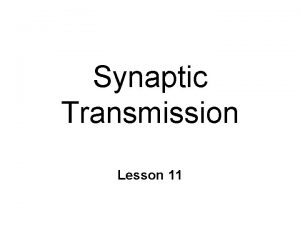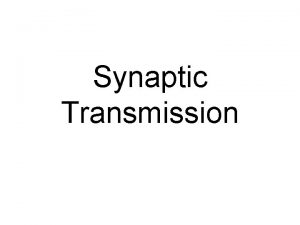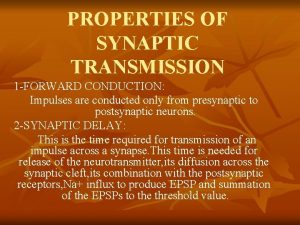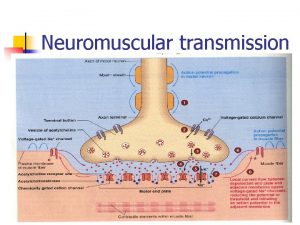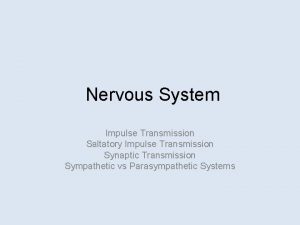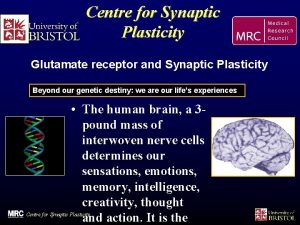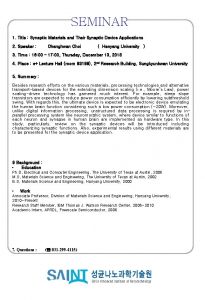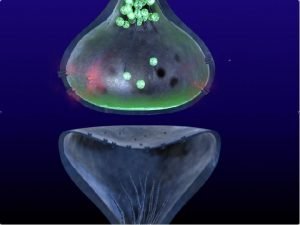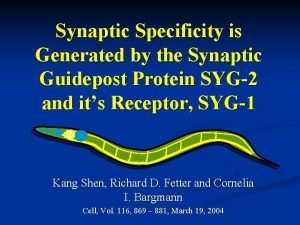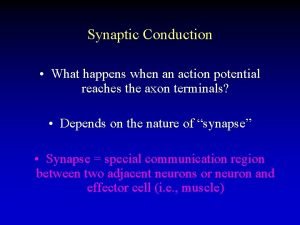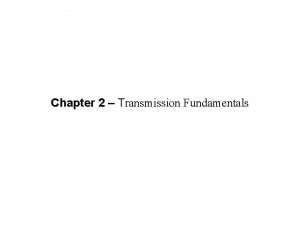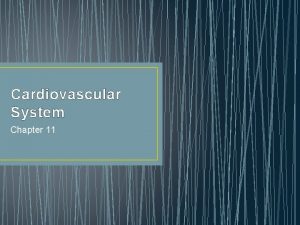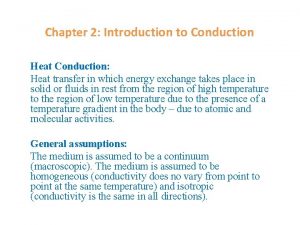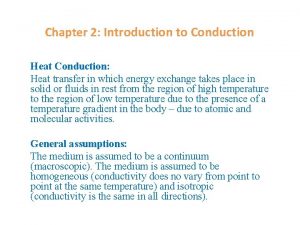Chapter 4 Neural Conduction and Synaptic Transmission How













































- Slides: 45

Chapter 4 Neural Conduction and Synaptic Transmission How Neurons Send and Receive Signals This multimedia product and its contents are protected under copyright law. The following are prohibited by law: • any public performance or display, including transmission of any image over a network; • preparation of any derivative work, including the extraction, in whole or in part, of any images; • any rental, lease, or lending of the program. Copyright © 2006 by Allyn and Bacon

The Neuron’s Resting Membrane Potential l l Inside of the neuron is negative with respect to the outside Resting membrane potential is about -70 m. V Membrane is polarized, it carries a charge Why? Copyright © 2006 by Allyn and Bacon

Ionic Basis of the Resting Potential l l Ions, charged particles, are unevenly distributed Factors influencing ion distribution • • Homogenizing Factors contributing to uneven distribution Copyright © 2006 by Allyn and Bacon

Ionic Basis of the Resting Potential l Homogenizing • • l Random motion – particles tend to move down their concentration gradient Electrostatic pressure – like repels like, opposites attract Factors contributing to uneven distribution • • Membrane is selectively permeable Sodium-potassium pumps Copyright © 2006 by Allyn and Bacon

Ions Contributing to Resting Potential l l Sodium (Na+) Chloride (Cl-) Potassium (K+) Negatively charged proteins (A-) • • synthesized within the neuron found primarily within the neuron Copyright © 2006 by Allyn and Bacon

The Neuron at Rest l l Ions move in and out through ion-specific channels K+ and Cl- pass readily Little movement of Na+ A- don’t move at all, trapped inside Copyright © 2006 by Allyn and Bacon

Equilibrium Potential l l The potential at which there is no net movement of an ion – the potential it will move to achieve when allowed to move freely Na+ = 120 m. V K+ = -90 m. V Cl- = -70 m. V (same as resting potential) Copyright © 2006 by Allyn and Bacon

The Neuron at Rest l l Na+ is driven in by both electrostatic forces and its concentration gradient K+ is driven in by electrostatic forces and out by its concentration gradient Cl- is at equilibrium Sodium-potassium pump – active force that exchanges 3 Na+ inside for 2 K+ outside Copyright © 2006 by Allyn and Bacon

Something to think about l l What would happen if the membrane’s permeability to Na+ were increased? What would happen if the membrane’s permeability to K+ were increased? Copyright © 2006 by Allyn and Bacon

Generation and Conduction of Postsynaptic Potentials (PSPs) l l Neurotransmitters bind at postsynaptic receptors These chemical messengers bind and cause electrical changes • • Depolarizations (making the membrane potential less negative) Hyperpolarizations (making the membrane potential more negative) Copyright © 2006 by Allyn and Bacon

Generation and Conduction of Postsynaptic Potentials (PSPs) l l Postsynaptic depolarizations = Excitatory PSPs (EPSPs) Postsynaptic hyperpolarizations = Inhibitory PSPs (IPSPs) EPSPs make it more likely a neuron will fire, IPSPs make it less likely PSPs are graded potentials – their size varies Copyright © 2006 by Allyn and Bacon

EPSPs and IPSPs l l l Travel passively from their site of origination Decremental – they get smaller as they travel 1 EPSP typically will not suffice to cause a neuron to “fire” and release neurotransmitter – summation is needed Copyright © 2006 by Allyn and Bacon

Integration of PSPs and Generation of Action Potentials (APs) l l In order to generate an AP (or “fire”), the threshold of activation must be reached at the axon hillock Integration of IPSPs and EPSPs must result in a potential of about -65 m. V in order to generate an AP Copyright © 2006 by Allyn and Bacon

Integration l l l Adding or combining a number of individual signals into one overall signal Temporal summation – integration of events happening at different times Spatial - integration of events happening at different places Copyright © 2006 by Allyn and Bacon

What type of summation occurs when: l l One neuron fires rapidly? Multiple neurons fire at the same time? Several neurons fire repeatedly? Both temporal and spatial summation occur simultaneously Copyright © 2006 by Allyn and Bacon

Copyright © 2006 by Allyn and Bacon

Copyright © 2006 by Allyn and Bacon

The Action Potential l l All-or-none, when threshold is reached the neuron “fires” and the action potential either occurs or it does not. When threshold is reached, voltageactivated ion channels are opened. Copyright © 2006 by Allyn and Bacon

The Ionic Basis of Action Potentials l l l When summation at the axon hillock results in the threshold of excitation (-65 m. V) being reached, voltage-activated Na+ channels open and sodium rushes in. Remember, all forces were acting to move Na+ into the cell. Membrane potential moves from -70 to +50 m. V. Copyright © 2006 by Allyn and Bacon

Copyright © 2006 by Allyn and Bacon

The Ionic Basis of Action Potentials l l l Rising phase: Na+ moves membrane potential from -70 to +50 m. V. End of rising phase: After about 1 millisec, Na+ channels close. Change in membrane potential opens voltage-activated K+ channels. Repolarization: Concentration gradient and change in charge leads to efflux of K+. Hyperpolaization: Channels close slowly - K+ efflux leads to membrane potential <-70 m. V. Copyright © 2006 by Allyn and Bacon

Refractory Periods l l l Absolute – impossible to initiate another action potential Relative – harder to initiate another action potential Prevent the backwards movement of APs and limit the rate of firing Copyright © 2006 by Allyn and Bacon

The action potential in action l l http: //intro. bio. umb. edu/111112/112 s 99 Lect/neuro_anims/a_p_anim 1/WW 1. htm http: //bio. winona. msus. edu/berg/ANIMT NS/actpot. htm Copyright © 2006 by Allyn and Bacon

PSPs Vs Action Potentials (APs) l l EPSPs/IPSPs Decremental Fast Passive (energy is not used) l l Action Potentials Nondecremental Conducted more slowly than PSPs Passive and active Copyright © 2006 by Allyn and Bacon

Conduction in Myelinated Axons l l Passive movement of AP within myelinated portions occurs instantly Nodes of Ranvier (unmyelinated) • • • Where ion channels are found Where full AP is seen AP appears to jump from node to node • Saltatory conduction • http: //www. brainviews. com/ab. Files/Ani. Salt. htm Copyright © 2006 by Allyn and Bacon

Structure of Synapses l Most common l Dendrodendritic – capable of transmission in either direction Axoaxonal – may be involved in presynaptic inhibition l • Axodendritic – axons on dendrites • Axosomatic – axons on cell bodies Copyright © 2006 by Allyn and Bacon

Synthesis, Packaging, and Transport of Neurotransmitter (NT) l NT molecules • Small • Synthesized in the terminal button and packaged in synaptic vesicles • Large • Assembled in the cell body, packaged in vesicles, and then transported to the axon terminal Copyright © 2006 by Allyn and Bacon

Release of NT Molecules l l Exocytosis – the process of NT release The arrival of an AP at the terminal opens voltage-activated Ca++ channels. The entry of Ca++ causes vesicles to fuse with the terminal membrane and release their contents http: //www. tvdsb. on. ca/westmin/science/ sbioac/homeo/synapse. htm Copyright © 2006 by Allyn and Bacon

Activation of Receptors by NT l l Released NT produces signals in postsynaptic neurons by binding to receptors. Receptors are specific for a given NT. Ligand – a molecule that binds to another. A NT is a ligand of its receptor. Copyright © 2006 by Allyn and Bacon

Receptors l l l There are multiple receptor types for a given NT. Ionotropic receptors – associated with ligand-activated ion channels. Metabotropic receptors – associated with signal proteins and G proteins. Copyright © 2006 by Allyn and Bacon

Ionotropic Receptors l l l NT binds and an associated ion channel opens or closes, causing a PSP. If Na+ channels are opened, for example, an EPSP occurs. If K+ channels are opened, for example, an IPSP occurs. Copyright © 2006 by Allyn and Bacon

Metabotropic Receptors l l Effects are slower, longer-lasting, more diffuse, and more varied. NT (1 st messenger) binds > G protein subunit breaks away > ion channel opened/closed OR a 2 nd messenger is synthesized > 2 nd messengers may have a wide variety of effects Copyright © 2006 by Allyn and Bacon

Copyright © 2006 by Allyn and Bacon

Reuptake, Enzymatic Degradation, and Recycling l l l As long as NT is in the synapse, it is active – activity must somehow be turned off. Reuptake – scoop up and recycle NT. Enzymatic degradation – a NT is broken down by enzymes. Copyright © 2006 by Allyn and Bacon

Small-molecule Neurotransmitters l l Amino acids – the building blocks of proteins Monoamines – all synthesized from a single amino acid Soluble gases Acetylcholine (ACh) – activity terminated by enzymatic degradation Copyright © 2006 by Allyn and Bacon

Amino Acid Neurotransmitters l l Usually found at fast-acting directed synapses in the CNS Glutamate – Most prevalent excitatory neurotransmitter in the CNS GABA – • synthesized from glutamate • Most prevalent inhibitory NT in the CNS Aspartate and glycine Copyright © 2006 by Allyn and Bacon

Monoamines l l l Effects tend to be diffuse Catecholamines – synthesized from tyrosine • • • Dopamine Norepinephrine Epinephrine Indolamines – synthesized from tryptophan • Serotonin Copyright © 2006 by Allyn and Bacon

Soluble-Gases and ACh l l Soluble gases – exist only briefly • • Nitric oxide and carbon monoxide Retrograde transmission – backwards communication Acetylcholine (Ach) • • Acetyl group + choline Neuromuscular junction Copyright © 2006 by Allyn and Bacon

Neuropeptides l l Large molecules Example – endorphins • “Endogenous opiates” • Produce analgesia (pain suppression) • Receptors were identified before the natural ligand was Copyright © 2006 by Allyn and Bacon

Pharmacology of Synaptic Transmission l Many drugs act to alter neurotransmitter activity • Agonists – increase or facilitate activity • Antagonists – decrease or inhibit activity • A drug may act to alter neurotransmitter activity at any point in its “life cycle” Copyright © 2006 by Allyn and Bacon

Copyright © 2006 by Allyn and Bacon

Agonists – 2 examples l Cocaine - catecholamine agonist • Blocks reuptake – preventing the activity of the neurotransmitter from being “turned off” l Benzodiazepines - GABA agonists • Binds to the GABA molecule and increases the binding of GABA Copyright © 2006 by Allyn and Bacon

Copyright © 2006 by Allyn and Bacon

Antagonists – 2 examples l l Atropine – ACh antagonist • Binds and blocks muscarinic receptors • Many of these metabotropic receptors are in the brain • High doses disrupt memory Curare - ACh antagonist • Bind and blocks nicotinic receptors, the ionotropic receptors at the neuromuscular junction • Causes paralysis Copyright © 2006 by Allyn and Bacon

Copyright © 2006 by Allyn and Bacon
 Tapetum lucidum
Tapetum lucidum Function of multipolar neuron
Function of multipolar neuron Synaptic gutter or trough
Synaptic gutter or trough Synaptic gutter
Synaptic gutter Lippincott williams & wilkins
Lippincott williams & wilkins Synaptic integration
Synaptic integration Cherrell triplett
Cherrell triplett Synaptic integration
Synaptic integration Screenless display abstract
Screenless display abstract Sequence of events at the neuromuscular junction
Sequence of events at the neuromuscular junction Describe capacities newborns display
Describe capacities newborns display Chapter 19 disease transmission and infection prevention
Chapter 19 disease transmission and infection prevention Chapter 19 disease transmission and infection prevention
Chapter 19 disease transmission and infection prevention Chapter 19 disease transmission and infection prevention
Chapter 19 disease transmission and infection prevention Compare and contrast conduction and convection
Compare and contrast conduction and convection Chapter 15 infection control
Chapter 15 infection control Which is the best surface for reflecting heat radiation
Which is the best surface for reflecting heat radiation Venn diagram of liquid and gas
Venn diagram of liquid and gas Linear heat conduction lab report
Linear heat conduction lab report What is heat transfer conduction convection and radiation
What is heat transfer conduction convection and radiation Conduction and breakdown in commercial liquids
Conduction and breakdown in commercial liquids Venn diagram of conduction, convection and radiation
Venn diagram of conduction, convection and radiation Which is the best surface for reflecting heat radiation?
Which is the best surface for reflecting heat radiation? Methods of heat transfer
Methods of heat transfer Whats conduction convection and radiation
Whats conduction convection and radiation Convection conduction radiation
Convection conduction radiation Electroscope simpop
Electroscope simpop Picture examples of convection
Picture examples of convection Heat transfer mechanisms
Heat transfer mechanisms Define thermal energy
Define thermal energy How are conduction convection and radiation alike
How are conduction convection and radiation alike Example of heat transfer
Example of heat transfer Following charting convection used in work study
Following charting convection used in work study Conduction convection radiation diagram
Conduction convection radiation diagram Visualizing and understanding convolutional neural networks
Visualizing and understanding convolutional neural networks Show not tell generator
Show not tell generator Deep neural networks and mixed integer linear optimization
Deep neural networks and mixed integer linear optimization Fig 19
Fig 19 Humoral neural and hormonal stimuli
Humoral neural and hormonal stimuli Least mean square algorithm in neural network
Least mean square algorithm in neural network Instar and outstar in neural network
Instar and outstar in neural network Neural and hormonal communication
Neural and hormonal communication Neural networks for rf and microwave design
Neural networks for rf and microwave design Visualizing and understanding neural machine translation
Visualizing and understanding neural machine translation Show attend and tell
Show attend and tell Fuzzy logic lecture
Fuzzy logic lecture
